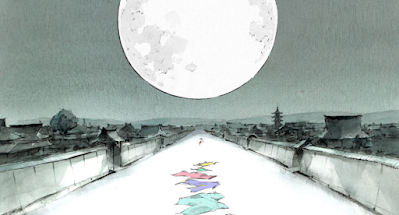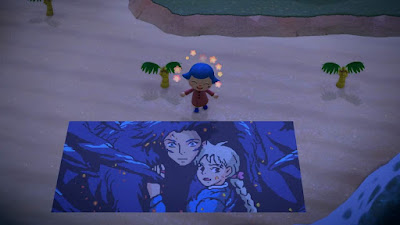Since Ghibli Blog is now beginning its 15th season, I wanted to celebrate by taking a look at this website's top nine articles. These are the most popular posts based on page views and are based on current stats. Let's take a look at our greatest hits and the stories behind them:
1. Mononoke Hime (1980) - The Original Miyazaki Book (2008)
This post originally posted translated pages of the 1980 Mononoke Hime book that composed of storyboards for an unrealized animation project. This post sat unnoticed for three years until an article on io9 brought a lot of new traffic. Internet forums and message boards soon joined in, and word of Miyazaki's storybook spread far and wide. In 2014, Viz Media announced that they would publish the Mononoke book in the US, and so I deleted most of the pages on my post, leaving a sample of pages and encouraging readers to buy the new book.
Was Ghibli Blog responsible for making that happen? Eh, probably not, but who knows?
2. Totoro is Not the God of Death (2007)
I read about a conspiracy theory floating around Japan that My Neighbor Totoro is actually a horror movie based on a real-life massacre of two children. In this telling, Totoro is a gruesome "God of Death" who functions like a fuzzy Grim Reaper who carries children to their graves. I wrote this post to gently debunk the idea. As the conspiracy meme swept the internet, my post was used as a handy rebuttal.
Unfortunately, the "Sayama Incident" conspiracy theory refused to die, which led me to
writing a more forceful rebuttal ten years later. Even Studio Ghibli was forced to make a public statement debunking the meme.
3. BREAKING: Disney to Acquire Studio Ghibli in 2014, Takahata and Miyazaki to Retire (2013)
This was my great April Fools joke on Ghibli Blog, and it caused panic attacks from fans throughout the world. And the best part is that they remained scared after realizing it was a prank. Comments continued through the following April. The illustration was not created by me, but found online. I never knew who drew it, but it looks terrific and the joke could never have worked without it.
4. "This Page Intentionally Left Blank" (2011)
This was the Downloads page, one of the main menu items on the site. I posted links to movie and television downloads, largely Toei Doga and Pre-Ghibli works. Most of the links pointed to an anime fan site called Baka BT. A few years ago, they completely shut down their torrent downloads and have closed all new memberships to their forum.
In 2015, I closed everything down and just left the page blank. I didn't want to cause any trouble, definitely didn't want to be tagged as a "pirate" website. And so the page is now blank and unlisted.
5. Ghibli Museum Sketching Set - Miyazaki Teaches You How to Paint (2015)
This informative post shared details of a paint set that was sold at the Ghibli Museum in Japan. Created under Hayao Miyazaki's personal supervision, this set included a set of 24 watercolor paints and a full-color comic drawn by the director who teaches you how to paint, offering several examples of his own work. Ghibli Freaks familiar with Heidi and the House Foods commercials that appear on Ghibli ga Ippai Short Short.
This post remains one of the most popular on Ghibli Blog to this day, which is great. I'm happy to share useful little gems such as this. Somebody ought to produce that paint set in the West!
6. What's the Deal With the Disney Princesses? (2011)
A short, snarky post featuring a cool cut-and-paste collage asking hard questions of all the famed "Disney Princesses" that were enormously popular among children and Disney fans. This is one of those quick bits that I'd zip out in five minutes, mostly as a lark and never deserving more than five seconds' attention. So, naturally, the internet grabbed it and ran wild for months.
It did spark a fascinating discussion about gender roles in Disney cartoons, both pro and con, and I think that's a good thing.
7. Heidi, Girl of the Alps Arrives on Blu-Ray (2012)
The arrival of the magnificent Blu-Ray box set of the landmark 1974 anime classic sparked interest from international fans, many of whom grew up watching Heidi and similar anime shows as children. This is a good example of a solid news article that connects with readers, and it demonstrates the popularity of Heidi around the world. This Blu-Ray set really ought to be released globally, but I fear the legal costs surrounding broadcast rights and dubbed soundtracks make this all but impossible.
8. Studio Ghibli Blu-Rays (Japan) - 2012 Holiday Edition
Another informative news post, this time showing the then-growing library of Studio Ghibli Blu-Ray releases in Japan. These discs came packaged in cardboard cases and included color booklets and postcards of the original movie posters. At the time, very few Ghibli movies were available in the West on Blu-Ray or DVD, leading diehard fans to import shops to pay a premium price for the expensive JP discs.
Today, all of Ghibli's theatrical features are now available on Blu-Ray, courtesy of our friends at GKIDS. Back in 2012, we weren't nearly so lucky. Heck, I remember importing DVDs back in 2005 before anybody knew any of these movies existed. How times have changed.
9. Studio Ghibli Feature Film Blu-Rays (2012)
This article was published in January 2012, whereas the previous article appeared in December. Once again, we see images of all the Studio Ghibli movies released on Blu-Ray in Japan, all of which look and sound fantastic and beat the pants off anything Disney was doing. At the time this article posted, Japan had eight movies on BD, while the US had only two. And those two, Nausicaa and Ponyo, both had problems with picture or sound that irritated fans.
Have I mentioned lately how much we all love GKIDS for their glorious treatment of Studio Ghibli? Go buy all their Blu-Rays as quickly as possible!


























